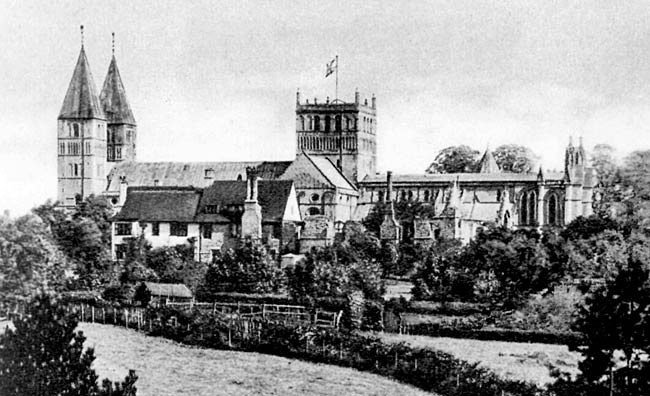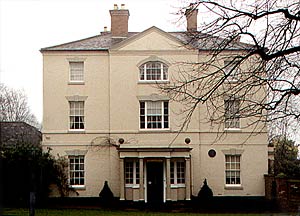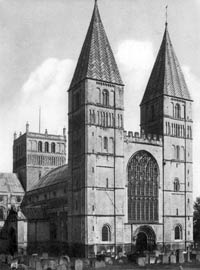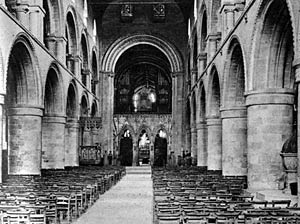< Previous | Contents | Next >
The Wonderful Minster
SOUTHWELL. Is there in England, we wonder, a greater surprise for most of those who come, for here is the least-known cathedral in our Motherland, with a dignity and beauty unsurpassed. The rushing tide of life has passed it by and left it standing in a quietude of loveliness, like some dream of time gone by before our century came.

Southwell Minster from the south in the 1930s.
A small place still, a "city" with only 3000 people, it has a proud and ancient tale to tell. It was the first of our Stuart kings who came this way and was astonished to find so great a church in so small a place; it was his son Charles Stuart who rode out of these streets on his last journey as a free man. It was here in Southwell, at the Saracen's Head, that he stayed a few hours before giving himself up to the long captivity which brought him to the scaffold. The inn is still as he saw it; he would ride through these great gates; he would see these beams before he mounted his horse and surrendered to the Scots encamped at Kelham.
Southwell had seen history before he came, for its wells brought the Britons here. There is witness to the Romans and the Saxons in the noble Minster which has grown from a very early church and a rebuilding perhaps in the first half of the 11th century. Here came Archbishops of York to rest awhile from their labours, some of them indeed for their last long sleep. There are. still fine fragments of their medieval house, which has been rebuilt in our time and is now the Palace of the Bishops of Southwell, for Southwell was made a bishopric in 1884. Now the diocese has been transferred from the province of Canterbury back to York, to which, until nearly a hundred years ago, it belonged for about a thousand years.

Burgage Manor, Southwell, in 2001.
Here Wolsey came in the summer after he had fallen, like Lucifer, never to rise again. While he was at Harrow and Cambridge, Byron spent his holidays here with his mother at Burgage Manor House, and it was because of his friendship here with Miss Pigot (the Eliza of his early poems) that his Hours of Idleness were published through a Newark printer. Several fine houses in beautiful gardens and parkland add to the charm of this old town on the River Greet, the birthplace of the composer, Reginald Spofforth, who wrote Hail, Smiling Morn.
Of one garden hereabouts an interesting tale is told. In the neighbourhood of Southwell is Easthorpe, and in a garden there stands (or lies, for it is on its back) an apple tree of historic interest to botanists. It began its life at the beginning of last century in a plant-pot, into which the lady of the house set two or three pips from an apple she was eating. Two or three seedlings grew up and the strongest of these was planted in the garden in Trafalgar year. It grew, but did not bloom for years. Then the house came to be inhabited by a Mr Bramley. The tree now bore a good crop of apples, and one day Mr Henry Merryweather, of Southwell, met a gardener carrying a fine basket of them. "It is Mr Bramley's apple," he said," and a very fine one too; it grows in his garden at Easthorpe." Mr Merryweather went to see Mr Bramley, who said he had named the apple Bramley's seedling, and Mr Merryweather might take what grafts he liked. Mr Merryweather eventually sent to the Fruit Committee at Chiswick 16 apples weighing 16 pounds, and the fruit received a fine certificate so that Mr Merryweather went to Easthorpe and said "Now, Mr Bramley you have the honour of raising and I have the honour of sending out the finest apple on earth."So Bramley's seedling came into the world, and the old tree which grew from the plant pot is still to be seen, its long life over but its trunk supported on two props. It might have been possible, by some miracle of arithmetic, to count the apples that have grown on this one tree, but no man knows how many trees have grown from one apple a lady of Easthorpe ate about 140 years ago.

The west front of Southwell Minster in the 1930s.
It was the Archbishop of York who began the Minster we see about 1110, after he had released the people of Notts from the annual pilgrimage to York on condition that they came to the church of St Mary of Southwell. Before the middle of the 13th century the small Norman choir had been replaced by the choir we see, a superb example of the Early English style at its best. The vestibule and the exquisite chapter house to which it leads were built between 1290 and 1300, and the richest stone screen in all England was set up 30 years later. The 15th century gave windows to the aisles, and the great west window, whose virtue it is that it throws light into the nave.
We come to the Minster through one of its old gateways, its Norman arch under a stepped gable with a medieval niche. By it are two beautiful yew pyramids, planted over a hundred years ago and still tended by the Southwell nurserymen who gave the world the famous apple known as the Bramley Seedling.
As we walk between the churchyard lawns, the fine west front is before us, standing as it stood in the 12th century except for the great window, and the square broached spires (the pepper-pots) with which the twin towers were crowned last century. The fifth storey of one of these high towers is enriched with Norman interlaced arcading, while that of its companion has a series of pointed arches. The west doorway is splendid with zigzag ornament, which also adorns many of the windows and the stringcourse running round the Norman part of the church. On both sides of the west doors is beautiful old ironwork in scrolls.
A stately square tower rises from the middle of a cross. The Norman two-storeyed north porch (a charming feature of the exterior) has a barrel roof looking down on arcaded walls and a recessed doorway with seven orders of ornament. It frames a 600-year-old traceried door.

The nave of Southwell Minster in the 1930s.
We should enter by the west doorway, for here the grandeur of the Norman nave bursts upon us. Sturdy round columns with carved capitals with strength enough to last for ever support the moulded arches. Over them runs a stringcourse like the edge of a saw. Then comes the triforium, with wide arches on short shafts, and above these the smaller arches of the clerestory passage, which is lighted by the small round windows seen outside.
Very solid and impressive is this great nave, leading to the four colossal arches bearing up the central tower. They are carved with exceptionally bold cable moulding, and the capitals on which the eastern arch rests are among the earliest Norman work here, their dainty carving showing the Annunciation, the Nativity, the Entry into Jerusalem, Our Lord washing Peter's feet, and the Last Supper (portrayed with a gap at the table). For forty years these capitals were hidden by the organ; now only part of the organ is on the stone screen, and the carvings are revealed.
The north and south arches of the crossing open to transepts as old as the nave. The nave has a 19th century barrel roof, but the aisles have their original Norman vaulting. The undercutting of the capitals and the ornament in the mouldings, are striking features of the lovely vaulted 13th century choir, which has a triforium and a clerestory. We come to the choir through a pair of charming iron gates in the middle bay of the stone screen; a gift in memory of a mother, they were made in our time by the blacksmith of Brant Broughton.
The screen itself is a miracle in stone. It has looked as we see it for about 600 years, and is marvellous for its fine sculpture even in this place where the artist's chisel has produced what John Ruskin called the gem of English architecture.
Enthroned high up in this wonderful screen sits the Madonna, a beautiful figure with an angel beckoning her. On each side of the doorway are three stone stalls; one of them, carved at the back in about 200 diaper squares, was Cardinal Wolsey's seat when he lived at the bishop's palace after his fail. Along the top of the screen runs a row of carved heads, and over the stalls are exquisite canopies elaborate with foliage and finials, and heads hanging from the cusps. Everywhere on this screen we see the genius of the medieval artist at his best. Altogether there are 289 figures, an immense number when we consider the little space into which they are crowded.
To those who wonder at the quaint and curious things we sometimes find in our cathedrals, the Southwell screen is a wondrous picture book, for it is easy to gather from it something of the medieval craftsman's mind. It was not just a joke that he made plants grow out of a mouth, or chiselled ugly people; his strange grotesques were not just passing fancy. In those days before books this was the way of teaching; these things were the people's library, their picture gallery, their Bible. An ugly man was a bad man, the man with his tongue out was a gossip. Those who will interest themselves in these things will find these ancient sculptures full of good philosophy, with virtues and vices personified. We find here the head of a woman who seems to be in terror, and looking across we find the reason why, for there is a man like a brute. On one of the brackets is David playing the harp; on another is Saul falling on his sword in his tent; small as it all is, the pain in Saul's face is clearly seen. There is an exquisite suggestion of an angel listening, with the forefinger held up in a way familiar to us all.
We can see at a glance, looking across the choir to the sanctuary, that the beautiful seats for the priests must have sprung from the same mind and been done by the same hands as the screen. The five seats in the sedilia (the sixth has gone) are superbly canopied, but the canopies have been broken and were restored at the beginning of the 19th century. They seem no worse for it, but remain one of the most captivating achievements of craftsmanship in the country. The seats are divided by slender columns round which cluster the tiniest human figures tucked away among the foliage. There are about 75 of them, and about half are the originals. Groups of figures run along the top; a group showing the Flight into Egypt has a very fine head of Joseph which it is difficult to believe was carved in the middle of the 14th century. The tiny cusps have gems of sculpture hanging from them, and the roofs of the canopies are vaulted and bossed.
An admirable place is Southwell to those who believe the best days of the world have not yet been, that all the best work has not been done, for here, in this choir so full of beauty, the work of our own' time is worthy of the old. Where this 14th century stone is wonderful, the 19th century woodwork is wonderful too. It is as if the man who set these seats in this great choir was moved by the spirit of beauty about him. It was Charles Henry Simpson who carved this marvellous range of oak stalls in the last years of the 19th century. They are of a delicate beauty everywhere, crowded with gems of carving which carry the mind to the chapter house a few yards away, where the carving has made Southwell famous through the world.
In these oak choir stalls is every kind of conception that comes to a carver who studies Nature in her infinite variety. There are many kinds of nuts and berries, mistletoe, honeysuckle, bullrushes, sun-flowers, catkins, and lilies of the valley. There are thistles, clover, buttercups, and wild roses. There is a holly tree which would prick us if we touched it. There is bracken with leaves too delicate to touch. There is an arm-rest with primroses and butterflies, and ears of wheat with mice playing among them. There are birds in a fig tree, a serpent in an apple tree, a lizard in an oak tree, and two pigs eating acorns that have fallen. There are bats and fishes and toadstools, and peas in a pod, and we think the artist must have been very fond of music, for he has put among all this foliage something of the music of the countryside, a fiddle and a harp, a bird singing by its nest, and a lark at heaven's gate.
Much of the carving runs right through the oak, and everywhere it has the variety of the garden and the fields. The pulpit matches the stalls in teak; it is very fine, with a Madonna and Child in the centre panel under the canopy.
